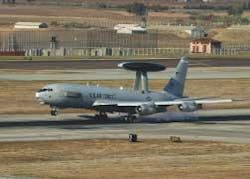Computers
Air Force looks to Veridian, Ixiasoft for server-based manuals
Officials of the U.S. Air Force needed server-based electronic interactive technical manuals for use throughout the Air Force. They found their solution in the Textml Server from Veridian Corp. Systems Division in Arlington, Va., and Ixiasoft in Montreal.
Ixiasoft officials struck a global enterprise license agreement with Veridian for a version of the Textml Server within the Air Force Common Viewer. Veridian had originally partnered with Ixiasoft in 2001 by embedding Textlm Server at the core of the TPM component of the ITOOLS product.
ITOOLS supports Air Force maintenance personnel by providing browser-based access to electronic technical manuals for the E-3 Airborne Warning and Control System (AWACS) aircraft.
This product is a document preparation, search, retrieval, and viewing solution for the Air Force. The initial project led the Air Force to development of the Air Force Common Viewer (AFCV) for the A-10, B-52, C-130, F-16, and the HH-60 aircraft, Ixiasoft officials say.
With this agreement, the Air Force will be able to provide all Air Force integrated electronic training manual users with the AFCV installed locally on their laptops. The AFCV enables electronic manual users to access thousands of pages of technical material and perform complex searches, all while running on a laptop. Users will also be able to maintain the currency of their technical manuals by logging on to the Air Force's intranet to download document updates, company officials say.
"The AFCV will be the standard tool that Air Force maintainers use to service weapons systems," says Bruce Watson, AFCV Project Manager at Veridian Systems.
"Textlm Server was designed to deliver fast access to large volumes of documents, all while running on minimal hardware," says Philippe Gelinas, President of Ixiasoft. "By installing the AFCV on thousands of laptops, the Air Force is exploiting the benefits of Textlm Server as its design was intended. We are extremely proud of this achievement through our association with Veridian and the Air Force."
Textlm Server is an XML content server that stores, indexes, and retrieves XML content for XML applications such as electronic manuals, content management systems, wireless content publishing, enterprise portals, or patient record systems.
For more information contact Ixiasoft by phone at 514-279-4942, by fax at 514-279-3947, by e-mail at [email protected], by post at 825 Querbes Ave., suite 200, Montreal, Quebec H2V 3X1, or on the World Wide Web at http://www.ixiasoft.com/.
Also contact Veridian Systems Division by phone at 703-527-4975, by fax at 703-524-2420, by post at 1400 Key Blvd., Suite 100, Arlington, Va. 22209-2369, or on the World Wide Web at http://www.veridian.com/.
Displays
Army TRADOC chooses RGB scan converter to digitize simulation imagery
Officials of the U.S. Army Training and Doctrine Command at Fort Monroe, Va., needed high-quality scan conversion for video production of 3D combat simulations on CDs and DVDs. They found their solution in the RGB/Videolink 1690 scan converter from RGB Spectrum of Alameda, Calif.
The RGB/Videolink is notable for its ability to preserve the fine, intricate detail of the simulation imagery, says Toni Spica, vice president of sales at RGB Spectrum.
"The goal was to evolve the Army's combat simulations into a more potent tactical decision-making tool, incorporating more realistic battlefield depictions, more accurate battlefield scenarios, and post-scenario tactical analysis capability," Spica says.
"The project entailed devising new real time 3D simulations and creating post-simulation analysis video reports for distribution on CDs and DVDs," he says. "Once they created the improved 3D combat simulations, the challenge was to produce video recordings that provided high-quality reproduction of the simulations' complex details." The RGB/Videolink converts the Army's complex 3D high-resolution combat simulations to video format.
The process begins at image-generation workstations, which produce realistic, real-time 3D combat simulations. These simulations cover complex elements such as scenarios depicting artillery ordnance trajectories, RGB officials say.
The RGB/Videolink scan converter receives the workstation's 3D imagery in 1280-by-1024-pixel resolution and converts it to S-Video. The converted images flow to a Sony DVCAM digital tape deck for storage. Later, experts edit the video on a PC to create video reports for post-simulation analysis of tactical maneuvers, strategy, and decision-making. Technicians duplicate the video reports onto CDs and DVDs and distribute them to U.S. Army facilities.
The RGB/Videolink 1690 transforms computer signals to broadcast-standard video in real time. Technicians can then record, broadcast, display, or transmit these computer-generated images over video codecs, company officials say.
The unit offers NTSC/PAL composite video, S-Video, and component analog video (Betacam/MII) outputs. SMPTE 259M digital output is available as an option.
For more information contact RGB Spectrum by phone at 510-814-7000, by fax at 510-814-7026, by post at 950 Marina Village Parkway, Alameda, Calif. 94501, or on the World Wide Web at http://www.rgb.com/.

